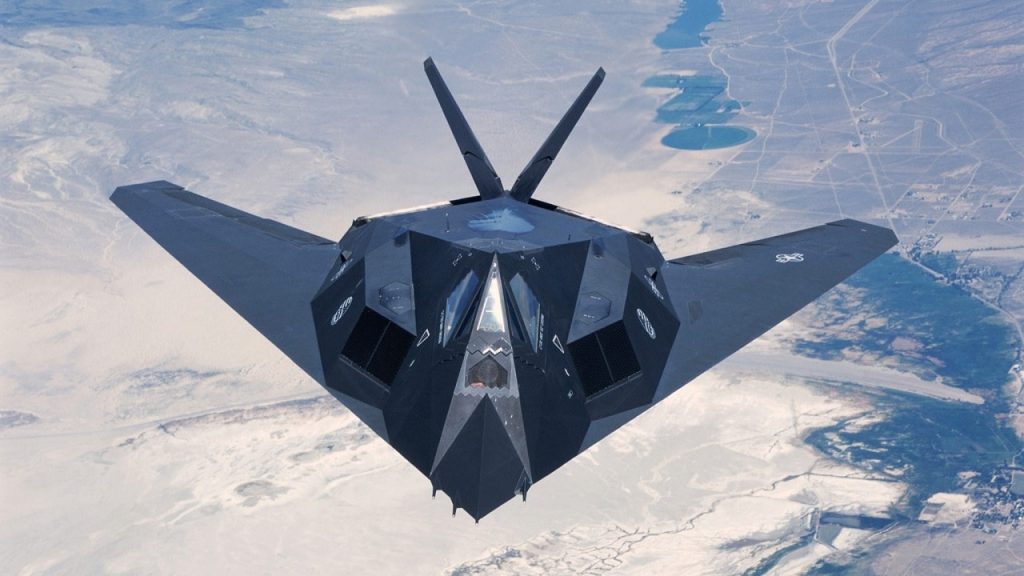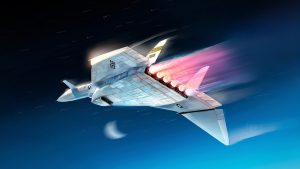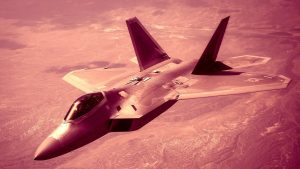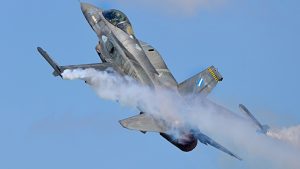Between 1981 and 1990, 59 were constructed. In 2008, the F-117 was officially decommissioned by the United States Air Force to make room in the budget for the F-22, the real stealth fighter.

The years of conjecture by the media (MSM) and the general public were put to rest when the military confirmed the existence of the F-117 Nighthawk stealth “fighter” in November 1988. (I put quotes around “fighter” since that’s an inaccurate description, as I’ll explain below.)
After one of the still-secret planes crashed in Bakersfield, California, in July 1986, speculation reached a fever pitch in the mainstream media. Testor’s so-called “F-19 Stealth Fighter” 1:48 scale plastic model kit was the best-selling model kit of all time, overtaking AMT’s U.S. S. Enterprise thanks largely to the public’s creative imagination around the fighter jet.
Soon after the Defense Department announced the plane’s existence to the public, mocking T-shirts appeared, proclaiming the F-117A “The U. S. Air Force’s Best Kept Secret.” (At least one of my old school buddies wore one of these tees.) Let’s look back at the life of this extraordinary bomber, sorry, fighter, now that the metaphorical cat has been out of the bag for 33 years (well, time does fly, albeit not so quietly).
Before DARPA’s Have a Blue program of the 1970s, the F-117 was just another successful warplane developed by Lockheed’s (now Lockheed Martin’s) legendary Skunk Works program. But by the time the Nighthawk took off from Groom Lake, Nevada, on June 18, 1981, Skunk Works’ legendary founder and mastermind, Clarence “Kelly” Johnson, had been retired for six years. In October of 1983, the Nighthawk was declared fully operational.
As I’ve already pointed out, calling the F-117A a “stealth fighter” is misleading, as she is instead strictly a ground attack plane, capable of carrying 2,000 pounds (910 kilograms) worth of laser-guided “smart” bombs, and the nuclear B61 bomb. Cannons and missiles would have compromised the radar signature and canceled the “stealth” advantage.
However, the plane was subsonic, with a maximum airspeed of 684 mph (Mach 0/92/1,100 kph/594 knots), making it too slow and weak in mobility to compete with real fighters of the fourth generation, such as the MiG-29 Fulcrum. Some people called it the “Wobblin’ Goblin” because of its supposed instability at low speeds, but its pilots have said this moniker is unfair. Names like “hopeless diamond,” “roach,” and “stinkbug” have also been applied to her.
Despite its unattractive name, the Nighthawk proved to be an effective fighter in battle, much like another “ugly” warplane, the A-10 Warthog. The F-117 never got to drop that B-61 nuclear bomb because the Soviet Union disintegrated. Nonetheless, the warplane would soon participate in an extensive, conventional aviation battle, further solidifying her legendary status.
During Operation Cause over Panama in December 1989, the F-117 got her first taste of combat. If anything, that first taste of battle was a letdown, but that mission was only a lull before the stormy Operation Desert Storm.
Although precision-guided munitions had already been combat-tested during the Vietnam War, the concept and efficacy of smart bombs were introduced to the general public and MSM during the 1991 air campaign against Saddam Hussein’s Iraqi regime, making the “Stealth Fighter” a virtual overnight sensation. Dario Leone of The Aviation Geek Club pointed out that the “overnight” part was, in some ways, rather literal:
According to James Goodall’s book F-117 Stealth in Action, “the F-117As of the 37th TFW was the first manned USAF aircraft to fly inside hostile Iraqi airspace.” He explains that on January 17 at 1:30 in the morning, About sixty 2,000-pound bombs were dropped by two F-117A squadrons against a major Iraqi air defense command. They control structures, ammunition bunkers, SCUD surface-to-surface missile bunkers, missile storage facilities, and the Iraqi Air Force headquarters. Thirty-one percent of all targets assaulted in the first twenty-four hours of the conflict were attacked by F-117As. On the first night of the war, the F-117As were the only aircraft participating in attacks on heavily fortified locations in and around Baghdad. The first bomb of the war was dropped by an F-117A, which targeted a communications facility in Baghdad.
The F-117 continued to perform admirably throughout 1999’s Operation Allied Force, 2001’s Operation Enduring Freedom, and 2003’s Operation Iraqi Freedom. During Allied Forces, The Nighthawk, flown by Lt. Col. Dale Zelko, was shot down by an SA-3 “Goa” missile on March 27, 1999. it causes the shattering of the plane’s aura of invincibility and invisibility. Yugoslav Army Col. Zoltán Dani of the 250th Air Defense Brigade operated the SA-3 “Goa” missile. There isn’t enough room to go into great detail on how Col. Dani did it, but BBC News’ Guy De Launey gives us the gist:
“Zoltan had the gear adjusted to work beyond the typical wavelengths, and he credited Serbian electrical genius Nikola Tesla with the idea. Perhaps this is how he identified Dale Zelko’s stealth fighter: “When it struck, it felt fantastic.” “It’s like netting the game-winning goal,” Mr. Dani explains. Lt. Col. Zelko escaped unharmed after ejecting from the jet. The De Launey essay tells the fascinating human interest narrative of the postwar friendship that blossomed between these two former enemies. After his heroic act, Dani, a national hero in Serbia, now owns and operates a thriving bakery in the Serbian capital.
Between 1981 and 1990, 59 were constructed. In 2008, the USAF retired the Nighthawk to make room in its budget for the F-22 Raptor, the world’s first genuine stealth fighter. Some warplanes can be seen at the Ronald Reagan Presidential Library in Simi Valley, California, and other museums across the United States.






